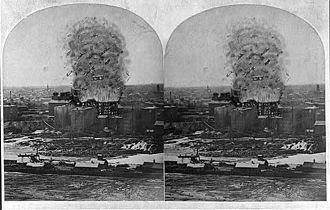Dust explosion
Dust explosion
A dust explosion is a rapid combustion of fine particles suspended in the air, often in an enclosed location. Dust explosions can occur where any dispersed powdered combustible material is present in high enough concentrations in the atmosphere or within another gaseous oxidizer such as oxygen.
Mechanism
Dust explosions occur when a fine dust is suspended in the air in an enclosed space and ignited. The primary factors in a dust explosion are the concentration of the dust, the presence of an ignition source, and the confinement of the dust cloud. When these conditions are met, the dust can ignite and cause a rapid increase in pressure, leading to an explosion.
Common Combustible Dusts
Many materials that are commonly thought of as non-combustible can burn rapidly when in a finely divided form. Some examples include:
- Grain dust
- Coal dust
- Metal dust (such as aluminum and magnesium)
- Plastic dust
- Wood dust
Prevention and Mitigation
Preventing dust explosions involves controlling the dust concentration, eliminating ignition sources, and using proper ventilation. Some common methods include:
- Regular cleaning to prevent dust accumulation
- Using dust collection systems
- Implementing explosion venting and suppression systems
- Grounding and bonding to prevent static electricity
Historical Incidents
Several significant dust explosions have occurred throughout history, leading to loss of life and property. Some notable incidents include:
- The Imperial Sugar refinery explosion in 2008
- The West Pharmaceutical Services explosion in 2003
- The Port Wentworth explosion in 2008
Regulations and Standards
Various organizations have established regulations and standards to prevent dust explosions. In the United States, the Occupational Safety and Health Administration (OSHA) and the National Fire Protection Association (NFPA) provide guidelines and standards for handling combustible dusts.
See Also
References
External Links
Transform your life with W8MD's budget GLP-1 injections from $125.
W8MD offers a medical weight loss program to lose weight in Philadelphia. Our physician-supervised medical weight loss provides:
- Most insurances accepted or discounted self-pay rates. We will obtain insurance prior authorizations if needed.
- Generic GLP1 weight loss injections from $125 for the starting dose.
- Also offer prescription weight loss medications including Phentermine, Qsymia, Diethylpropion, Contrave etc.
NYC weight loss doctor appointments
Start your NYC weight loss journey today at our NYC medical weight loss and Philadelphia medical weight loss clinics.
- Call 718-946-5500 to lose weight in NYC or for medical weight loss in Philadelphia 215-676-2334.
- Tags:NYC medical weight loss, Philadelphia lose weight Zepbound NYC, Budget GLP1 weight loss injections, Wegovy Philadelphia, Wegovy NYC, Philadelphia medical weight loss, Brookly weight loss and Wegovy NYC
|
WikiMD's Wellness Encyclopedia |
| Let Food Be Thy Medicine Medicine Thy Food - Hippocrates |
Medical Disclaimer: WikiMD is not a substitute for professional medical advice. The information on WikiMD is provided as an information resource only, may be incorrect, outdated or misleading, and is not to be used or relied on for any diagnostic or treatment purposes. Please consult your health care provider before making any healthcare decisions or for guidance about a specific medical condition. WikiMD expressly disclaims responsibility, and shall have no liability, for any damages, loss, injury, or liability whatsoever suffered as a result of your reliance on the information contained in this site. By visiting this site you agree to the foregoing terms and conditions, which may from time to time be changed or supplemented by WikiMD. If you do not agree to the foregoing terms and conditions, you should not enter or use this site. See full disclaimer.
Credits:Most images are courtesy of Wikimedia commons, and templates, categories Wikipedia, licensed under CC BY SA or similar.
Contributors: Prab R. Tumpati, MD





